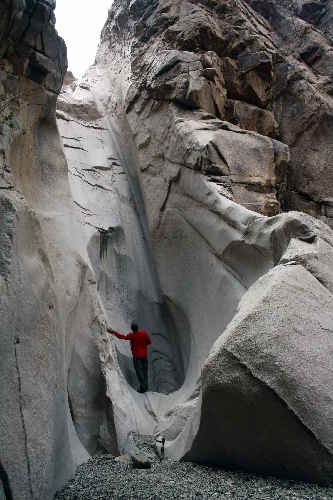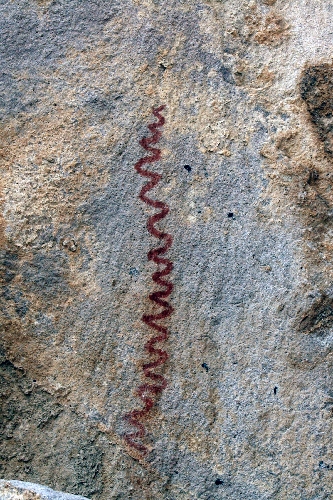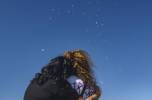Keyhole Canyon’s rocks a canvas for nature, ancient art


If you can hit the trail early on these days of late spring, you can still sneak into a few lower-elevation destinations before temperatures soar into the misery range. A good point for such a dawn attack might be Keyhole Canyon in the western foot of the Eldorado Mountains about 20 miles south of Boulder City. Here you will be able to enjoy a short hike into a lovely box canyon with a dryfall and also see some fine examples of prehistoric American Indian petroglyphs and pictographs.
This is an especially good excursion for small children or for those who can’t walk very far but are still eager to enjoy the outdoors. The trailhead is at an elevation of 2,854 feet, so it might be a few degrees cooler than Las Vegas. From the parking area, follow the wire-and-wood fence to the mouth of the canyon, where you enter through a hikers gate.
Concentrate your attention on the left side, up and down the cliff face and boulders, and you will be able to see plenty of petroglyphs, pecked or carved into the rock faces by pre-historic American Indians.
While many of the rock panels stand out, quite a few are so faded you will not even know they are there unless the light is hitting them just right. To get a closer look at the panels, be sure to bring binoculars, for many are otherwise inaccessible. Even if you have the climbing skills, it would be irresponsible to scramble up the decorated rock face for a closer look, now that we know the very touch of human hands will damage an irreplaceable record of vanished cultures.
As you start to walk into the canyon, you will notice two large slabs of rock on your right, both of which you can walk under. If you walk under the second one and look up on your left, you will see a few pictographs — prehistoric rock paintings. One has a human form and another looks like an insect of some sort. Stepping in a bit farther and looking higher, you will see one that looks like a long snake.
Pictographs are rarer than petroglyphs. They are often found in a protected place such as this, where nature and time haven’t worn them away. The colors of these remain quite brilliant in color compared to some others I have seen in Southern Nevada. They were painted with red ocher, a natural clay pigment.
Back in the canyon proper, just continue farther in, and after about 100 yards and on the left side you will come to a lovely water-worn dryfall. The whole fall is polished smooth, but on the right side is a deep, narrow groove on the right side, where the water flow has been concentrated over many years.
After you are done exploring the canyon but before you return to the hikers gate in the fence, be sure to walk the base of the cliffs, where even more rock art awaits you.
Keep an eye out on top of some of the flat-topped boulders in this area and you might notice many small teacup-size circular depressions. Called cuplets, these were man-made and are thought to have been used by American Indians for ceremonial purposes. Just like the rock art, these are very fragile, so don’t set anything on them, climb on them or touch them.
Once off U.S. Highway 95, the gravel access roads to Keyhole are usually in good shape, but to be on the safe side, I would recommend a high-clearance vehicle with off-road tires. If it is raining or threatens rain, stay off the road and out of the canyon as they are both subject to flash flooding.
Deborah Wall is the author of “Great Hikes, A Cerca Country Guide” and “Base Camp Las Vegas: Hiking the Southwestern States,” published by Stephens Press. She can be reached at deborabus@aol.com.
DIRECTIONS TO KEYHOLE CANYONFrom the intersection of U.S. Highway 95 and U.S. Highway 93 west of Boulder City, take U.S. 95 south toward Searchlight and drive about 15.7 miles. There is a road sign that indicates that there is a left turn but it is not named. Turn left carefully as you must cross the northbound lane. Follow the gravel road for about 2.1 miles and go right. Drive for about 1.8 miles and go left just after power line tower 23E3. Continue for about three-tenths of a mile to parking area.


















